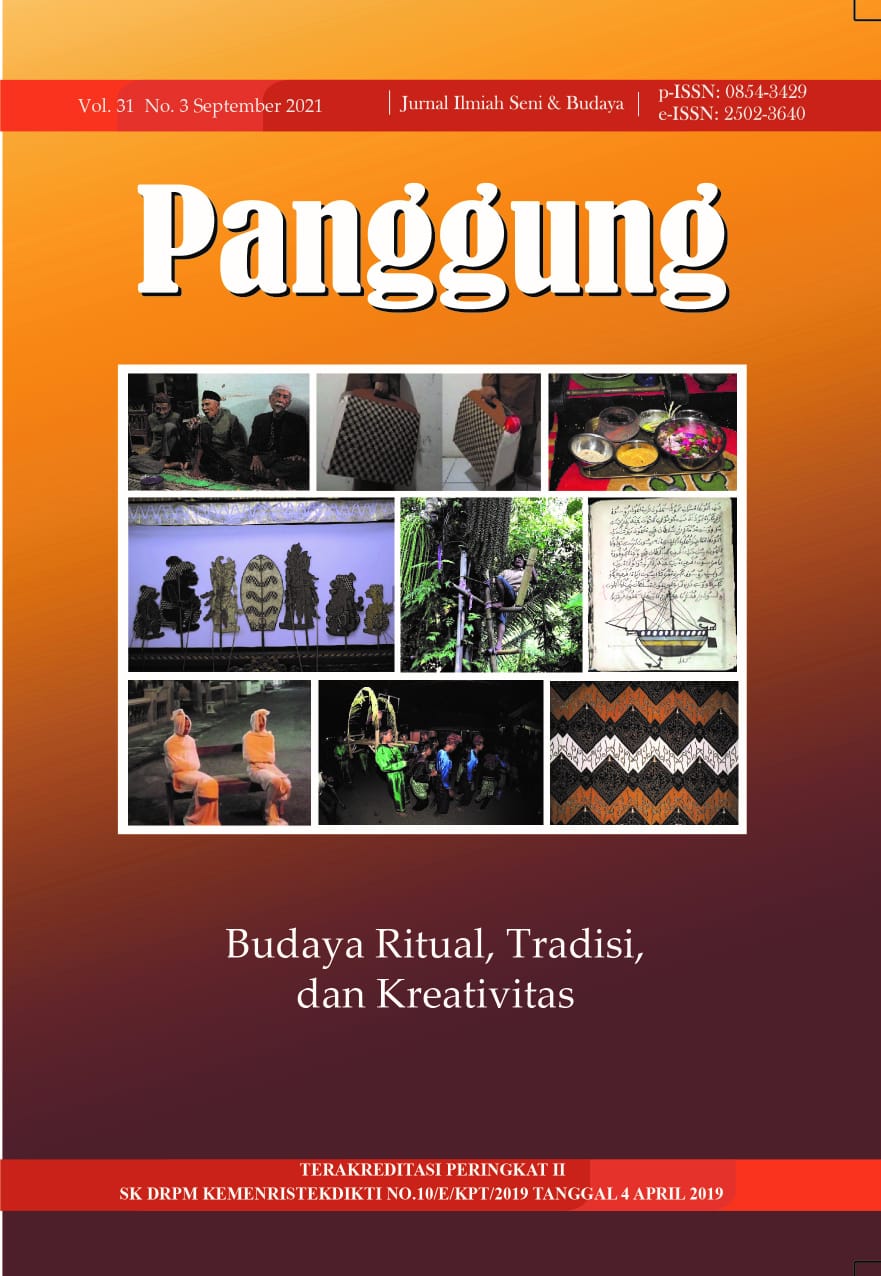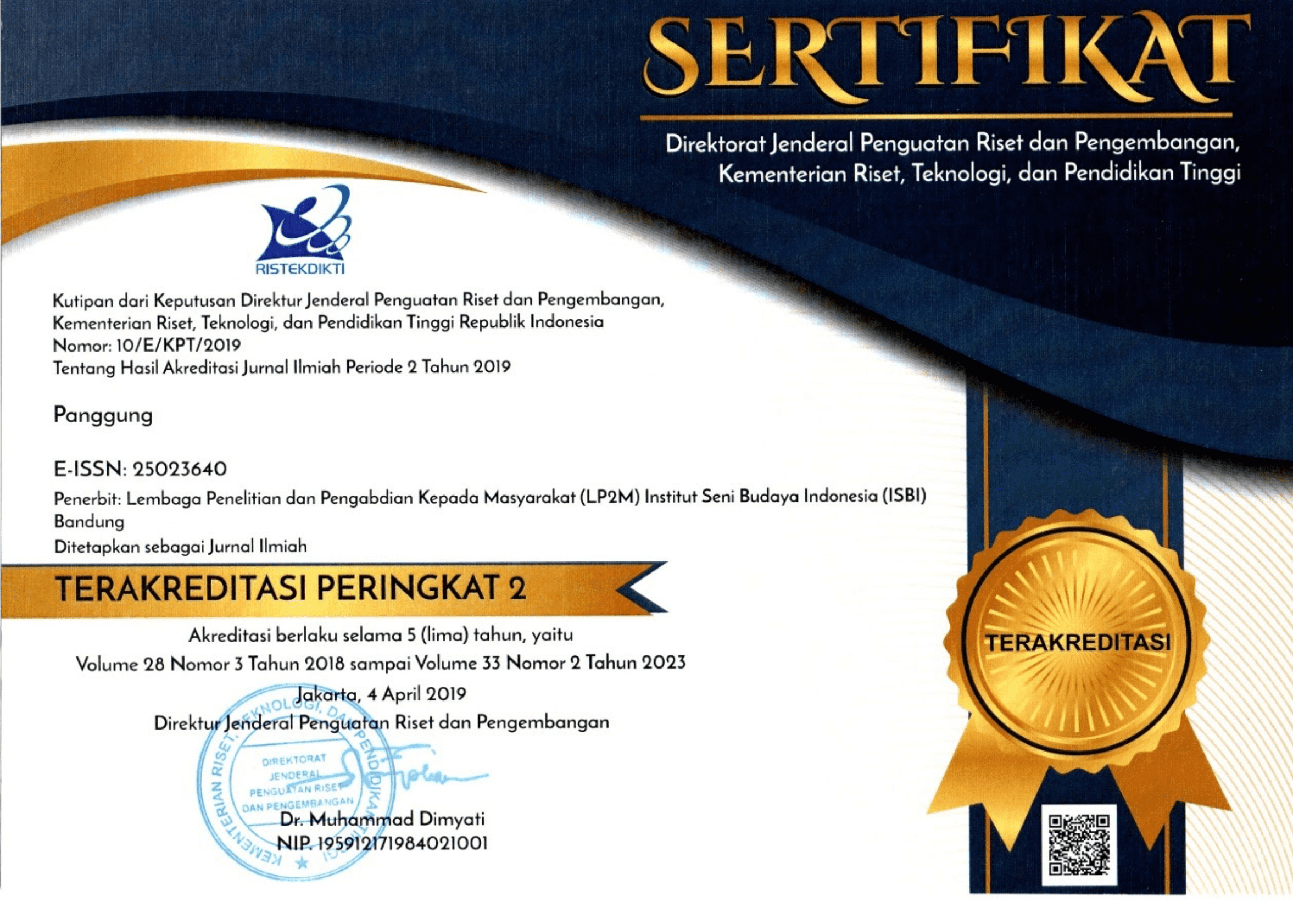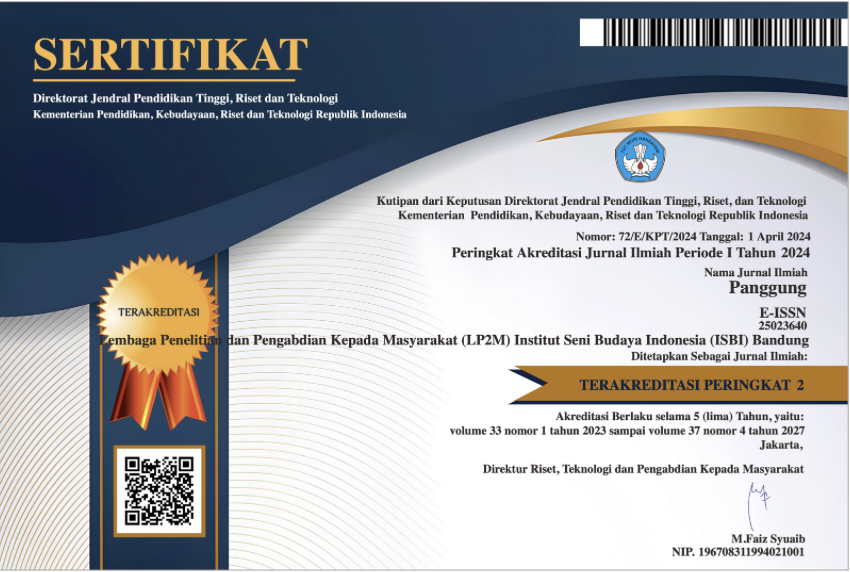Demitosisasi Pocong sebagai Media Sosialisasi Kampanye Stay at Home
DOI:
https://doi.org/10.26742/panggung.v31i3.1615Abstract
Di kegelapan malam terlihat dua pocong duduk di depan pos ronda Dusun Tuk Songo, Purworejo. Balutan kain putih mayat manusia dimanfaatkan sebagai media sosialisasi untuk membatasi mobilisasi warga selama pandemi Covid-19. Pentingnya penelitian ini dilakukan adalah untuk mengamati efektivitas pemanfaatan gagasan mitologi tradisi Jawa terhadap masyarakat moderen melalui pendekatan semiologi Barthes. Berdasarkan pengamatan, muncul makna konotatif berlebihan yang terlihat dari ekpresi ketakutan (fear) hingga keresahan (anxiety) pada anak dan remaja. Gagasan pemanfaatan media pocong jadi-jadian ini merupakan tindakan yang tidak disadari sebagai bentuk demitosiasi dengan tujuan kreativitas yang menghibur. Namun demikian gagasan ini justru menguatkan mitos pocong sebagai arwah orang mati yang masih dapat dijumpai dalam kehidupan moderen meski mengaku merasa beriman (remithology). Penelitian ini menyimpulkan demitosasi benda mistis-ritual pada media yang dituturkan berulang membangun wacana dan berhasil merubah perilaku warga untuk tetap di rumah. Temuan penelitian ini menyumbang pendekatan baru untuk mendisiplinkan masyarakat modern dengan pendekatan tradisi religiusitas lokal.
References
Aufa, A. A. (2017). Memaknai kematian dalam upacara kematian di Jawa. An-Nas: Jurnal Humaniora, 1(1), 1–11.
Barthes, R. (1967). Elements of semiology. Hill and Wang.
Barthes, R. (1972). Mythologies. Hill and Wang.
Budiman, K. (2003). Semiotika visual. Yayasan Seni Cemeti.
Chandler, D. (2007). Semiotics the basics. Routledge.
El-Shamy, H. M. (1967). Folklore behavior: A theory for the study of the dynamics of traditional culture. Indiana University.
Gagliardi, P. (2015). Myths and symbols: Organizational. International Encyclopedia of the Social & Behavioral Sciences: Second Edition, 16(1990), 179–182.
Geertz, C. (1957). Ritual and social change: A Javanese example. American Anthropologist, 59(1), 32–54.
Geertz, C. (1960). The religion of Java. The University of Chicago Press.
Gora, R., Tarsani, & Dwijayanti, R. I. (2020). The dynamics of communication on the identity crisis of malangan mask art in the cultural adaptation of Malang people. International Journal of Multicultural and Multireligious Understanding, 7(10), 364–377.
Ihejirika, C. I. C., & Edodi, S. O. (2017). Myths as contextual logic for social control: The Igbo example. African Research Review, 11(4), 192–207.
Irawan, A. M. (2012). Mythology construction in cosmetic advertisements adnd consumers’ cognition. Jurnal Inovasi Dan Kewirausahaan, 1(1), 38–46.
Karim, A. (2015). Makna kematian dalam perspektif tasawuf. Esoterik, 1(1), 21–46.
Kay, A. C., Gaucher, D., McGregor, I., & Nash, K. (2010). Religious belief as compensatory control. Personality and Social Psychology Review, 14(1), 37–48.
Kirk, C. P., & Rifkin, L. S. (2020). I’ll trade you diamonds for toilet paper: Consumer reacting, coping and adapting behaviors in the COVID-19 pandemic. Journal of Business Research, 117, 124–131.
Lee, M., & Johnson, C. (2007). Prinsip-prinsip pokok periklanan dalam perspektif global. Jakarta: Prenada Media Group.
Miftakhuddin, A. M., & Zulfiati, H. M. (2019). Misconceptions between Social Studies and Social Sciences among Pre-Service Elementary Teachers. International Journal of Education, 12(1), 16-25.
Murwonugroho, W., & Miftakhudin, M. (2020). Kajian Rupabheda: Tokoh-Tokoh Sri Tanjung pada Relief Candi Penataran. Panggung, 30(2).
Campaign in Election 2019. International Journal of Advanced Science and Technology 29(05)
Murwonugroho, W. (2019). Mediating Role of Social Media in the Memorability of Street Sculpture Art: Jogja Street Sculpture Project 2017 as Case Study. Wacana Seni Journal of Arts Discourse, 18.
Monticelli, D. (2016). Critique of ideology or/and analysis of culture? Barthes and Lotman on secondary semiotic systems. Sign Systems Studies, 44(3), 432–451.
Morales, S. S. (2013). Myth and the Construction of Meaning in Mediated Culture. Kome: An International Journal of Pure Communication Inquiry, 1(2), 33–43. https://doi.org/10.17646/kome.2013.13
Nasir, M. A. (2019). Revisiting the Javanese Muslim Slametan: Islam, local tradition, honor and symbolic communication. Al-Jami’ah, 57(2), 329–358.
Ormrod, J. E. (2016). Human learning (7th ed.). Pearson Education.
Perwitasari, N. H. (2020). Apakah sering bersin merupakan gejala terinfeksi gejala virus corona. Tirto.Id. https://tirto.id/apakah-sering-bersin-merupakan-gejala-terinfeksi-virus-corona-eHNc
Piaget, J. (1965). The origins of intelligence in children. International Universities Press, Inc.
Piaget, J. (2003). The psychology of intelligence. Routledge Classic.
Rengganis, M. T. (2020, September). Hikayat peti mati. Tempo.
Roy, D., Tripathy, S., Kar, S. K., Sharma, N., Verma, S. K., & Kaushal, V. (2020). Study of knowledge, attitude, anxiety & perceived mental healthcare need in Indian population during COVID-19 pandemic. Asian Journal of Psychiatry, 51, 102083.
Rozaki, A. (2020). Lockdown kampung: Siasat budaya mengatasi wabah Covid-19. UIN Sunan Kalijaga. https://uin-suka.ac.id/id/kolom/detail/47/blog-post.html
Rubin, M., Neria, Y., & Neria, Y. (2016). Fear, trauma, and posttraumatic stress disorder: clinical, neurobiological, and cultural perspectives. Interdisciplinary Handbook of Trauma and Culture, 303–313.
Scarnera, P. (2016). The myth as a tool for human behavior setting. International Journal of Social Science Studies, 4(7), 1–25.
Starner, Andrew, (2020). Remote viewing: a brief historical inquiry into theatre and social distance, International Journal of Performance Arts and Digital Media , Volume 16, 2020 - Issue 3: Special Themed Section: The Zoom Function.
Susanto, Moh. Rusnoto, at.all. (2019). Social Social Media Transformation In The Public Education: A Critical Review Of Social Change, Journal Of Scientific & Technology Research (IJSTR), Volume 8 - Issue 7, July 2019 Edition, Penerbit : IOP Publishing, ISSN 2277-8616
Susanto, Moh. Rusnoto, at.all. (2019). Contemporary Culture Transformation Through Virtual Space Cyberculture Perspective, International Journal of Recent Technology and Engineering (IJRTE), Volume 8 Issue-1C2.
Suyanto, M. (2006). Strategi Perancangan Iklan Outdoor Kelas Dunia.Yogyakarta: Penerbit Andi.
Tanjung, S. (2017). Deathless after death: Humanize the tradition and celebrate of death in Java. SHS Web of Conferences, 33.
Wessing, R. (2007). Dislodged tales: Javanese goddesses and spirits on the silver screen. Bijdragen Tot de Taal-, Land- En Volkenkunde, 163(4), 529–555.
Womack, K., & Davis, T. (2006). Mythology, remythology, and demythology: The beatles on film. In Reading the Beatles: Cultural Studies, Literary Criticism, and the Fab Four (pp. 97–109). State
Universty of New York Press.
Woodward, M. R. (1985). Healing and morality: A Javanese example. Social Science and Medicine, 21(9), 1007–1021. https://doi.org/10.1016/0277-9536(85)90422-8
Yahya, A. N. (2020). Survei RRI-Indo Barometer: Tingginya kekhawatiran warga atas wabah Covid-19. Kompas.Com. https://nasional.kompas.com/read/2020/03/20/13185191/survei-rri-indo-barometer-tingginya-kekhawatiran-warga-atas-wabah-covid-19?page=all
Zoellner, L. A., Ojalehto, H. J., Rosencrans, P., Walker, R. W., Garcia, N. M., Sheikh, I. S., & Bedard-Gilligan, M. A. (2020). Anxiety and fear in PTSD. In Emotion in Posttraumatic Stress Disorder. Elsevier Inc.
Downloads
Published
How to Cite
Issue
Section
Citation Check
License
Penulis yang menerbitkan jurnal ini menyetujui persyaratan berikut:
Penulis memiliki hak cipta dan memberikan jurnal hak publikasi pertama dengan karya yang secara simultan dilisensikan di bawah Creative Commons Attribution License yang memungkinkan orang lain untuk berbagi karya dengan pengakuan kepengarangan karya dan publikasi awal dalam jurnal ini.
Penulis dapat mengadakan perjanjian kontrak tambahan yang terpisah untuk distribusi non-eksklusif versi jurnal yang diterbitkan dari karya tersebut (misalnya, mempostingnya ke repositori institusional atau menerbitkannya dalam sebuah buku), dengan pengakuan atas publikasi awalnya dalam jurnal ini.
Penulis diizinkan dan didorong untuk memposting pekerjaan mereka secara online (mis., Dalam repositori institusional atau di situs web mereka) sebelum dan selama proses pengiriman, karena dapat menyebabkan pertukaran yang produktif, serta kutipan yang lebih awal dan lebih besar dari karya yang diterbitkan.
Authors who publish with this journal agree to the following terms:
Authors retain copyright and grant the journal right of first publication with the work simultaneously licensed under a Creative Commons Attribution License that allows others to share the work with an acknowledgement of the work's authorship and initial publication in this journal.
Authors are able to enter into separate, additional contractual arrangements for the non-exclusive distribution of the journal's published version of the work (e.g., post it to an institutional repository or publish it in a book), with an acknowledgement of its initial publication in this journal.
Authors are permitted and encouraged to post their work online (e.g., in institutional repositories or on their website) prior to and during the submission process, as it can lead to productive exchanges, as well as earlier and greater citation of published work.






